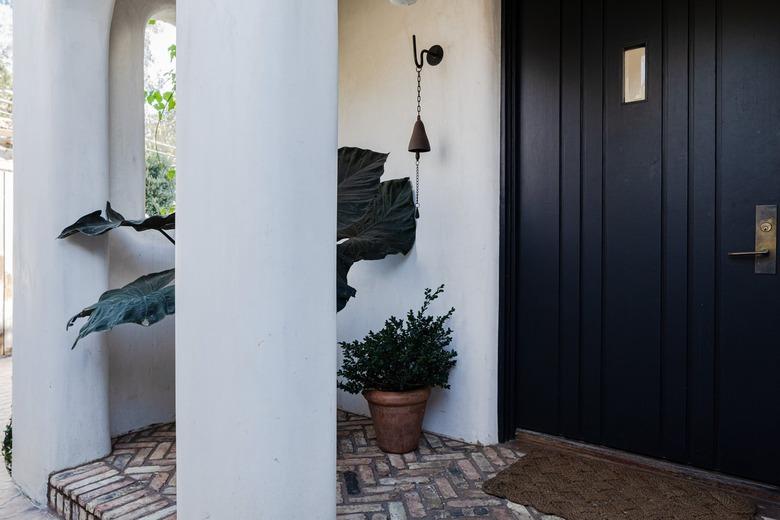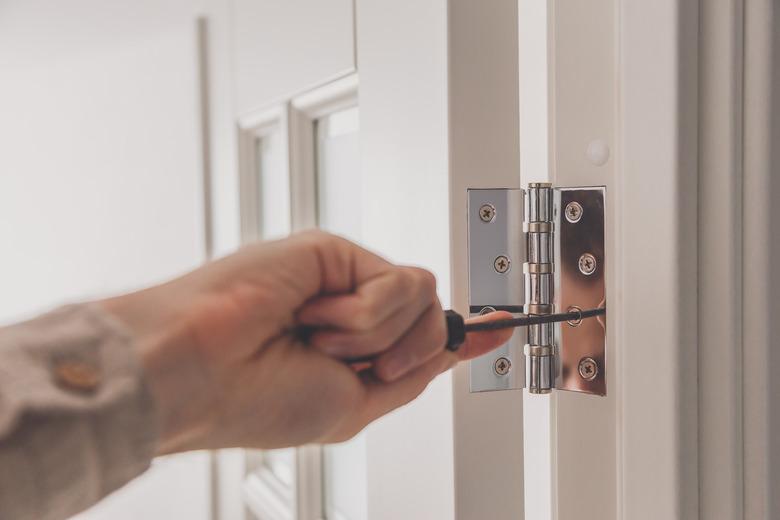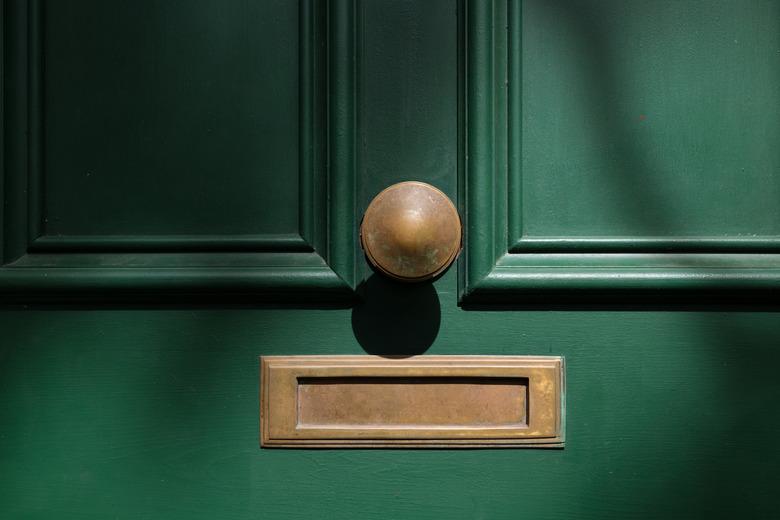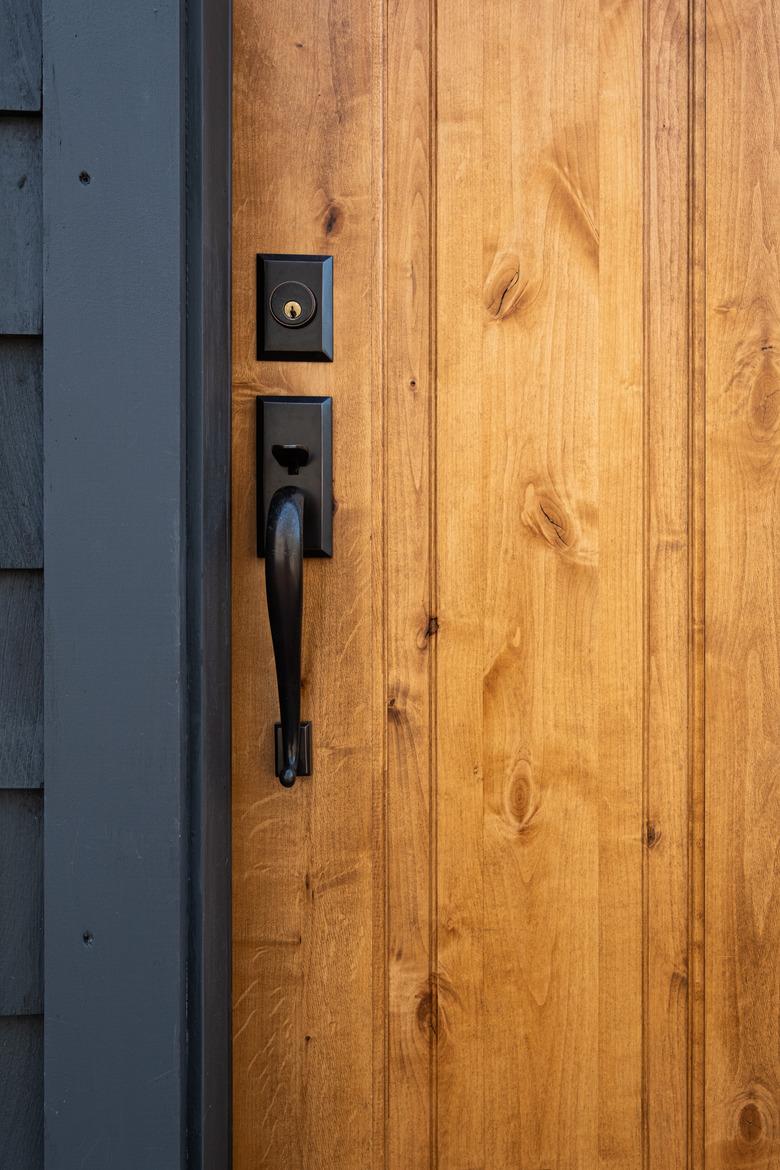What Hardware Do I Need For My Front Door?
Whether you are trying to change up the look of your front door, or you've purchased a slab door — which is one that isn't pre-mounted on a jamb and doesn't have any hardware — you'll want to know exactly what hardware you need before you head to the home improvement store or start perusing online.
Although it's easier to have all the door hardware preinstalled, not having it gives you the opportunity to customize the hardware to your personal preferences. An entry door handleset, for example, gives your door a radically different appearance than a traditional doorknob, and while exterior door hinges are pretty standard, there are a few designer options. Functionality is also customizable. You can find plenty of keyed entry door locksets, but if you're the type who habitually misplaces your keys or you're a landlord, you may prefer a keyless one instead.
You don't have to be installing a new door to take advantage of all the door hardware options because you can also retrofit the hardware on your existing door. Much of the hardware from top manufacturers, such as Schlage, Kwikset, and Baldwin, is interchangeable, so if you've always wanted an antique brass entry-door handleset, you can DIY the replacement of your existing lockset in short order.
Tip
Every door needs hinges and a doorknob. A front door usually also needs a deadbolt, and that's often coupled with the knob on a single plate or in a handleset.
Standard and Specialty Door Hinges
The most common front door hinge is the butt hinge, which consists of a pair of polished brass, rubbed bronze, satin nickel, or matte black leaves joined by a pin. The thickness and weight of the door determines the optimum length and width of the hinges (as well as the number of hinges you need), but on average, each leaf (the flat plate of the hinge) is typically 3 1/2 inches long, and the entire hinge is 3 1/2 inches wide. Hinges are typically 1/5 inch thick, which is the depth of the mortises you need to cut in the door and the door jamb to accommodate the hinge leaves.
The ball-bearing hinge is a variation on the standard butt design that incorporates ball bearings at the top and bottom of the hinge pin to allow for smooth operation of heavy doors. If you're looking for a more stylish option, consider olive knuckle hinges, which have olive-shaped joints that are visible from the inside when the door is closed. These hinges look great with ornate wooden doors, and they are wide throw, allowing the door to completely clear the jamb when open and providing a wider door opening.
Doorknobs and Levers
Besides hinges, you need to provide your front door with a way to open and close. Doorknobs and levers are two of the most common options, and although they basically operate in the same way, there are significant differences between them:
- Doorknobs have been around longer, so they tend to look more traditional. Levers often feature a sleek design that goes better with modern decor. There are also door handles operated by a thumb latch in both traditional and modern styles.
- A door lever is easier to operate than a knob and is a better choice for anyone with limited mobility. On the other hand, if you want to prevent children and pets from being able to open and close the door, choose a doorknob over a lever.
- If you frequently find yourself coming through the front door loaded down with groceries or with wet hands, choose a lever so you can operate it with your elbow in a pinch.
Entry doorknobs, such as the Kwikset Venetian, and door levers, such as the Schlage Latitude, are keyed, and their heavy-duty construction is designed to keep out intruders. They will also keep you out if you lose your keys. You can avoid this problem by installing a keyless entry knob or lever with an electronic keypad, such as the Schlage Plymouth doorknob or door lever. If you're a landlord, consider a handle or lock with smartkey technology that allows you to rekey it in just a few seconds.
All front doorknobs and door levers are designed for easy installation, although the size and backset (distance from the edge of the door) of the holes you need to drill for them may vary by model and by the width of the door. All models are supplied with a metal strike plate that you install on the door jamb after drilling or chiseling a hole for the latch bolt.
Deadbolts Are Recommended
By itself, a locking doorknob or lever might not provide enough security, so most people also install a deadbolt. When the deadbolt is supplied with the knob or lever as a matching set, the combination is usually called a lockset, although that term can also describe a locking door handle. Sometimes, the handle and deadbolt are mounted on a single plate, but it's just as common for them to be separate.
Either way, you have to drill separate holes in the door for the deadbolt and the handle unless you choose a mortise lock, which requires mortising a deep rectangular pocket in the door. This type of lockset usually has a pair of buttons mounted on the edge of the door; pressing one button engages the lock, and pressing the other one disengages it. A tubular lockset, on the other hand, fits into a hole — usually 2 1/8 inches in diameter — that you will need to drill in the door face. The latch bolt fits into a smaller hole — about an inch in diameter — drilled through the edge of the door into the larger hole.
Like locking door handles, deadbolts can be keyed or keyless. The keyed ones can be keyed from both sides of the door or have a thumb turn on the inside. Some of the more advanced keyless locks are Wi-Fi enabled, allowing you to lock and unlock the door with your mobile device. A smart lock like this isn't any more difficult to install than a conventional one except that you may have to mount a wireless receiver on the inside of the door.
One Handleset to Lock Them All
Do you want something more sophisticated than either a doorknob or door lever? A handleset sports a long, curved handle and a thumb latch that operates like a gate latch. It looks more difficult to install than a doorknob, but it isn't. The only difference is that you have to drive an extra screw or two into the bottom of the handle to secure it to the door. Handlesets (for example, the Schlage Camelot) usually come with matching knobs or levers for the inside of the door, and some have matching deadbolts that may or may not be mounted on the same plate as the handle.




